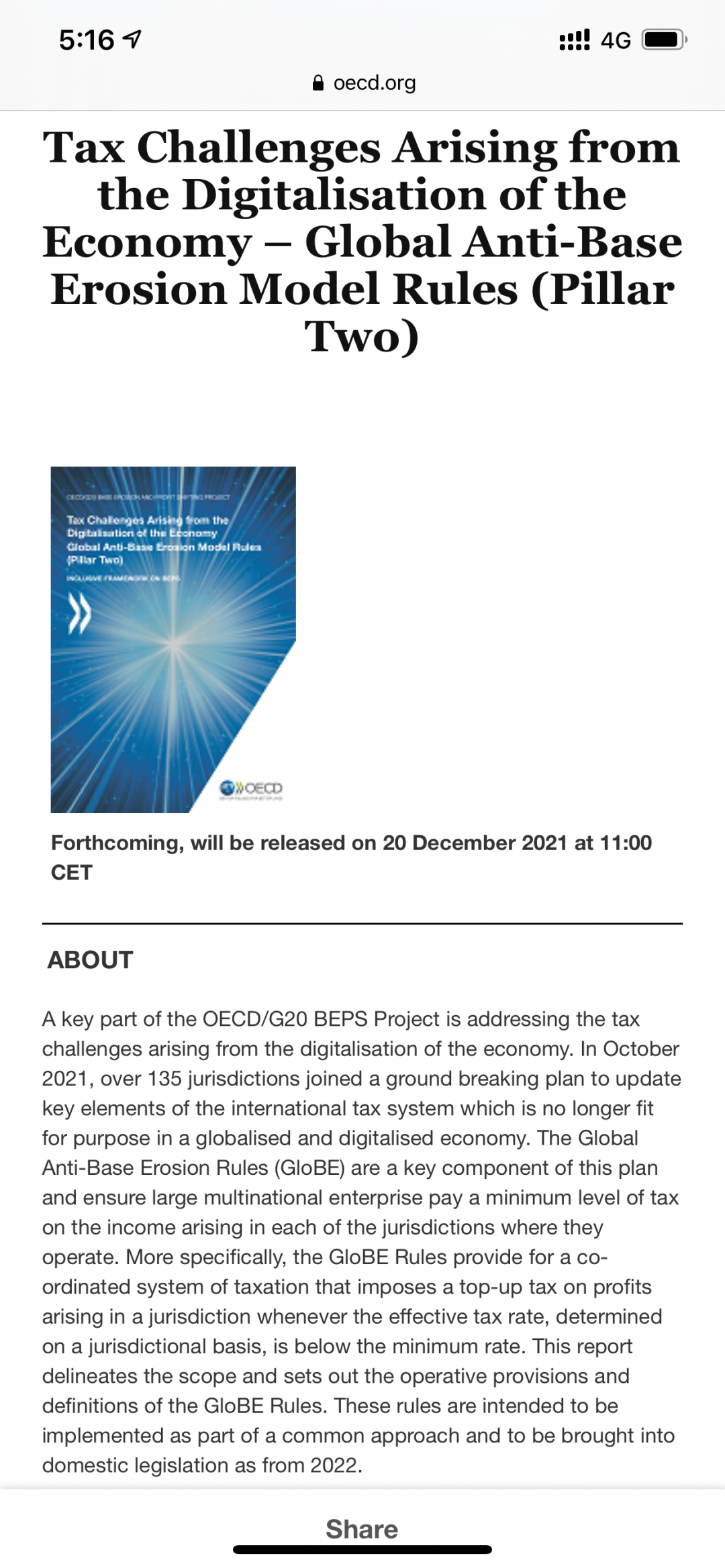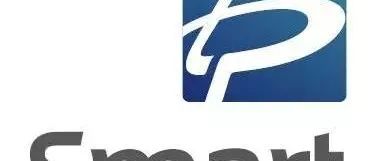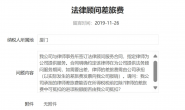|
|

编译整理:思迈特财税国际税收服务团队
据OECD官网最新消息,OECD将于法国当地时间12月20日上午11:00时发布《应对数字经济的税收挑战—全球反税基侵蚀(GLoBE,支柱二)示范规则》(以下简称“该示范规则或支柱二示范规则)。
2021年10月8日,OECD发布声明,在7月共识的基础上,BEPS包容性框架下140个成员中的136个国家(地区)就“双支柱”解决方案达成共识(截至目前,BEPS包容性框架下141个成员中的137个国家(地区)就“双支柱”解决方案达成共识)。
“双支柱”解决方案包括支柱一和支柱二:支柱一包括金额A和金额B,金额A还有配套的税收确定性机制,其针对现行国际税收规则体系中的联结度规则和利润分配规则进行改革,将跨国企业集团剩余利润在全球进行重新分配;支柱二包括基于国内法的全球反税基侵蚀规则(由收入纳入规则和低税支付规则构成)和基于税收协定的应税规则,其通过实施全球最低税,确保跨国企业集团在各个辖区承担不低于一定比例的税负,以抑制跨国企业集团逃避税行为,为各国税收竞争划定底线。
10月声明是对7月声明中的一些内容进行了补充和明确。但尽管如此,“支柱二”中仍有不少问题有待明确,比如,如何计算全球最低税的税基、公式化经济实质排除(即实质经营活动固定回报的扣除)中体现实质性经济活动的人员工资及有形资产这两个指标如何界定等等。
据彭博税务12月17日报道,对于“支柱二”中尚未明确的问题,OECD即将发布的该示范规则将明确如何计算全球最低税有关细节。
该示范规则已于12月2日下发给141个包容性框架成员征求意见,要求各成员国在OECD发布最终规则之前获得批准。如果各成员国在下周二(即12月21日,法国当地时间,下同)前没有提出反对意见,即表示该示范规则获得批准。据悉,在OECD正式发布支柱二示范规则后欧盟计划于12月22日发布一项指令,要求其27个成员国自行实施该示范规则。
据彭博税务报道,该示范规则对公式化经济实质排除中体现实质性经济活动的人员工资及有形资产这两个指标进行界定,即定义了合格的人员工资及合格的有形资产。合格的人员工资包括工资、医疗保险、养老金缴款和工资税;合格的有形资产包括位于某一辖区的项目,如财产、自然资源、承租人使用有形资产的权利,以及某些政府许可证。该示范规则同时对“时间差异”问题应如何处理进行了明确,即通过使用递延所得税会计原则来处理税基的问题。递延所得税税会计原则是一种会计处理方式,允许公司选择何时对与多年交易相关的利润纳税。
另据OECD官网最新消息,该示范规则旨在作为共同方法的一部分予以实施,并将从2022年起纳入各国国内立法。
相关资讯可查看以下相关NEWS。

NEWS 1: OECD to Publish Minimum Tax Model Rules on Dec. 20
SOURCE:Bloomberg Tax(Dec. 17, 2021)
The OECD willrelease model rules Dec. 20 for the recently agreed global minimum tax.
Nearly 140 countriessigned an agreement in October to create a 15% effective minimum rate forcorporations, known as Pillar Two. A separate provision of the deal, PillarOne, provides for a reallocation of a portion of the largest multinationals’profits to be taxed in more countries.
…
Full pressrelease:https://news.bloombergtax.com/daily-tax-report-international/oecd-to-publish-minimum-tax-model-rules-on-dec-20
NEWS 2: Leaked OECD Rules Paint Clearer Picture of Global MinimumTax
SOURCE:Bloomberg Tax(Dec. 16, 2021)
? More than 130 countries backed setting a15% minimum tax rate
? OECD-brokered deal set 2023 goal toimplement overhaul
The details aroundhow companies will have to calculate a newly agreed global minimum tax arenearing final form, according to a document seen by Bloomberg Tax.
The document—confirmed by a source familiar with discussions—sets out modellegislation for implementing the 15% minimum tax, known as Pillar Two. It wascirculated to the roughly 140 participating countries Dec. 2, asking for theirapproval before the Organization for Economic Cooperation and Developmentreleases final rules. According to the document, if countries didn’t object byTuesday the model legislation will be considered approved.
The OECD declined to comment.
The model rules—ifapproved—would fill in details on key open questions following countries’October agreement on the minimum tax—including defining what kind of payrolland tangible asset costs are eligible for a carve-out from the rule, and howthe rules will deal with timing differences between when profits are recordedand when taxes are paid.
Countries would beable choose to implement the minimum tax, known as Pillar Two, into theirdomestic legislation—basing their law on the model rules. The rules would beput to use almost immediately, with the European Union planning to release adirective Dec. 22 that would require its 27 member countries to implement therules themselves.
A Treasuryofficial recently publicly signaled the rules should be released in the comingweeks.
The other part ofthe global plan, known as Pillar One—which will reallocate a portion ofmultinationals’ profits to more countries—will be implemented through amultilateral treaty the OECD aims to complete in the first half of 2022.
Defining Carve-Outs
The document seenby Bloomberg Tax fills in more details about what income companies would beable to leave out of the minimum tax rules, including defining in detail whichtangible assets and payroll costs are eligible for the exclusion.
The Octoberagreement said companies would get a carve-out on income for 5% of the carryingvalue of their tangible assets and payroll, with a transition period thatoffers an exclusion of 8% of tangible assets and 10% of payroll.
The Dec. 2document would define eligible payroll costs to include salary and wages,health insurance, pension contributions, and payroll taxes. Eligible tangibleassets include items located in a jurisdiction, like property, naturalresources, a lessee’s right to use tangible assets, and certain governmentlicenses, including ones to exploit natural resources.
Timing Differences
One of thequestions facing the rules’ architects has been how the rules, which usefinancial accounting, should treat timing differences between when companiesreport their profits versus pay their taxes—for example, deals that spanmultiple years.
The Dec. 2document deals with this problem by using principles of deferred taxaccounting—an accounting treatment to allow companies to elect when they paytax on profits related to a transaction that stretches over multiple years.
A recapture mechanism puts a five-year limit on how long companies can keep deferring taxon certain items—like provisions they put aside for uncertain tax positions—untilthey have to pay minimum tax owed on them.
The rules alsolist types of gains and costs that can be deferred without the five-yearrestriction—including research and development expenses and foreign currencyexchange gains.
—With assistancefrom Chris Condon.
To contact thereporters on this story: Hamza Ali in London at hali@bloombergtax.com; IsabelGottlieb in Washington at igottlieb@bloombergtax.com
To contact theeditors responsible for this story: Meg Shreve at mshreve@bloombergindustry.com;Vandana Mathur at vmathur@bloombergtax.com
END
【特别提醒】针对2020年度及以前年度同期资料主体文档、本地文档及特殊事项文档准备,同学们如有任何疑问和需求,可通过以下方式联系我们,我们经验丰富的转让定价专业服务人员会及时为您答疑解惑。
联系人:谢维潮(高级合伙人)
电话:0755-82810900
手机:13088827747(微信同号,加好友请注明“同期资料咨询”) |
-

|

 京公网安备 11010802035448号
( 京ICP备19053597号-1,电话18600416813,邮箱1479971814@qq.com ) 了解Tax100创始人胡万军
优化与建议
隐私政策
京公网安备 11010802035448号
( 京ICP备19053597号-1,电话18600416813,邮箱1479971814@qq.com ) 了解Tax100创始人胡万军
优化与建议
隐私政策
 京公网安备 11010802035448号
( 京ICP备19053597号-1,电话18600416813,邮箱1479971814@qq.com ) 了解Tax100创始人胡万军
优化与建议
隐私政策
京公网安备 11010802035448号
( 京ICP备19053597号-1,电话18600416813,邮箱1479971814@qq.com ) 了解Tax100创始人胡万军
优化与建议
隐私政策

 【答疑】外单位员工的差旅费,我公司可否税
【答疑】外单位员工的差旅费,我公司可否税
 【全网最全】《互联网平台企业涉税信息报送
【全网最全】《互联网平台企业涉税信息报送
 【全网最全】国家税务总局黑龙江省税务局党
【全网最全】国家税务总局黑龙江省税务局党
 《育儿补贴制度实施方案》公布!每孩每年36
《育儿补贴制度实施方案》公布!每孩每年36








